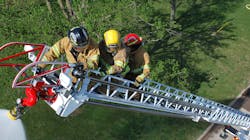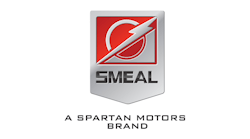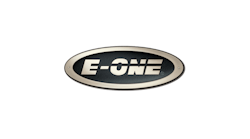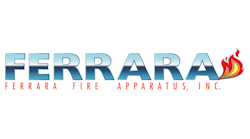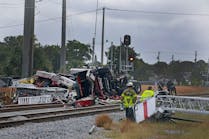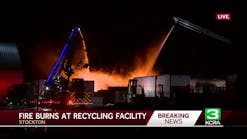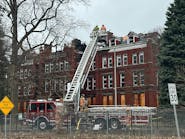For as long as firefighters have been trying to reach the sky, there’s been a debate over which material is best for ladders to help them fight fire from above.
Wood was the first material, followed by steel and aluminum. Wood has all but been abandoned, with just a single vendor making ground ladders out of the material, leaving steel and aluminum for apparatus-mounted ladders.
Some experts now say there’s really no difference between steel and aluminum, while others say steel is the only way to go. However, virtually everyone advocates fire departments choosing aerial devices based on performance and need, not just materials.
Firehouse spoke with experts from E-ONE, Ferrara, HME-Ahrens Fox, Smeal and Spartan Emergency Response to get their opinions on this age-old debate that sparks a passion rivaled only by the Ford versus Chevy feud.
E-ONE
Jim Salmi, the director of aerial product development for E-ONE, is considered one of the aerial gurus in the nation. He has more than 30 years of experience designing and building aerials, has been actively involved with industry organizations, serves as chairman of the aerial subcommittee of the Fire Apparatus Manufacturers Association (FAMA) and as a group chair for the National Fire Protection Association (NFPA).
“Ladder material has largely become a matter of department preference,” Salmi said. “It’s like the Ford or Chevy debate. When properly designed and validated, both are very viable materials to use for the fire service.”
He said a lot of people have strong opinions. “They’ll say 'I hate Ford, but does Ford make a good pickup truck, yeah.'”
While it might be a matter of personal opinion about which material is better, there are differences, Salmi said. For example, steel has a higher resistance to heat and it is minimally affected by higher temperatures. Aluminum requires tempering to strengthen it, Salmi said. Virgin aluminum has a strength rating of 15,000 to 18,000 psi, which can be increased to 35,000 to 38,000 psi through heat treating.
Conversely, it takes less heat to take the tempering out of the aluminum than steel. The integrity of aluminum should be checked when it’s exposed to temperatures of 300 degrees Fahrenheit and above. Steel, on the other hand, can withstand temperatures of up to 800 to 1,000 degrees Fahrenheit, Salmi said.
To make up the difference, aluminum ladder manufacturers use thicker materials, and can manage the weight because aluminum is one-third the weight of steel. Aluminum can also be extruded into shapes that are designed to handle stress and be stronger than the virgin material left alone.
“Lighter aerial devices can reduce the amount of outrigger stance needed for stability and reduce the set-up space,” Salmi said. “It comes down to which you are more familiar with. Chicago has steel and aluminum and they are happy with both materials.”
Salmi explained that steel has a greater surface hardness and it’s a tougher material whereas aluminum is not quite as resilient. The tradeoff is that steel is much more susceptible to rust and corrosion and it must be painted and sealed to keep out water, one of the key ingredients to rust.
“Steel ladder manufacturers go to great lengths to seal materials to prevent corrosion,” he said.
Aluminum, on the other hand needs very little to control corrosion, according to Salmi, who noted that aluminum doesn’t need any surface treatment. Some people like the look of the brushed swirling on the rails and other aluminum ladder components.
But, there’s a caveat to the corrosion issue, Salmi said. Aluminum and steel- and zinc-coated steel don’t like each other very much and if the materials touch each other, there can be corrosion on aluminum aerials as well, called galvanic corrosion. Salmi said aluminum is the sacrificial metal so it can possibly corrode when in contact with steel, stainless steel, or zinc-coated steels. So where the ladder interfaces with the turntable, or waterways, lights and other steel materials that get affixed to the aluminum aerial, there’s a chance for corrosion to occur. The designs most consider the means of isolation of the metals in areas of contact.
“So it goes both ways,” Salmi said of the corrosion issue.
Salmi also said aluminum extrusions mean the rungs can be shaped with tread grips already in place. On a steel aerial, the treads have to be affixed to the rungs by glue, epoxy or some other means.
Steel is an easier metal to weld than aluminum, according to Salmi, who noted that if a repair has to be made, there are generally more facilities with certified steel welders than aluminum. Steel welds can be visually and magnetic particle tested for defects and aluminum welds are normally visually inspected as well with an occasional use of dye penetrant to check for defects.
E-ONE, which is widely known for its aluminum aerial products, introduced a steel aerial last year. Salmi said it has nothing to do with one material being better than the other. Rather it has to do with competing in both the domestic and the world market.
Salmi said the international aerial market is dominated by steel and that has to do with the Germans who developed the first aerials, which were made of steel. So, that’s the material most of the world is familiar with.
“If you don’t have a steel product, you’re limited in the world market,” he said. “Steel is the standard in many countries around the world and if you don’t have it, you can’t compete."
So from Salmi’s perspective, the debate is really one similar to the “Ford vs. Chevy” argument.
“The higher strength steels that are now available at 100,000 psi yield allow the weights of steel and aluminum devices to be very similar,” Salmi said. “There really is very little performance difference between well-designed aluminum and steel aerials.”
Ferrara
Paul Christensen, the aerial sales manager for Ferrara Fire Apparatus, said when it comes to the aluminum versus steel aerial debate, the purchasers usually have very strong opinions.
“However, decisions like that ought not to be based on opinions, they ought to be based on performance,” Christensen said.
“They need to look at what is the aerial going to be used for, what the tip load needs to be, how much water will be flowed,” Christensen said. “That’s what ends up being the determining factor. You should base your decision on what the truck will carry and what kind of crew you have.”
Christensen said NFPA standards require every aerial manufacturer to have 2-to-1 safety factors as a minimum for loads and some manufacturers go higher on that ratio. Because of the standards, Christensen said most manufacturers’ equipment is going to weigh about the same.
“Aluminum is lighter than steel, that is true, when you look at the periodic table,” Christensen said. “But, structurally, everything is going to weigh just about the same. Everybody uses a torque box and jacks and axles, and they all weigh about the same.”
Ferrara constructs aerials out of steel and always has. “We’re really comfortable with steel,” Christensen said.
He said he’s always preferred steel aerials. “I like the solid feel of a steel aerial,” he said. “It gives you a really nice solid feel with no wiggle.”
Christensen said other advantages of steel is its usually painted and painted surfaces require less lube than unpainted. He added that Ferrara uses a corrosion inhibitor for its aerials and a base core of synthetic paraffin in the rungs to keep them from rusting inside out. Hand rails and trusses are 360-degree welded to inhibit rust. And, he said Ferrara tests every weld on every aerial. “Not all manufacturers test every weld,” Christensen added.
Ferrara also uses 100,000 psi-rated steel on its rear-mount aerials and 70,000 psi-rated steel on its mid-mounts and the difference is largely due to construction requirements. He said the flat stock milled ingots of 100,000 psi steel is not easily converted into tubes for the base cords of the lower two sections of a mid-mount aerial. Therefore, 70,000 pound steel is used there.
Christensen said each aerial is unique and fire departments need to evaluate what is going to work best for the department’s needs. “You need to look at who is going to perform better, not a gimmick in an ad,” Christensen said.
HME/Ahrens-Fox
HME/Ahrens-Fox has been building its own steel aerials for three years, said Ken Lenz, the company’s vice president of engineering.
The company choose steel for a few reasons, the first of which is the availability of high-strength alloy steel that has a 100,000 psi rating and is lightweight. The lighter weight steel helps reduce the overall weight of the vehicle. It also helps reduce the number of axles and stability equipment further cutting weight.
Additionally, Lenz said there was a very practical issue that led to the decision to use steel instead of aluminum—it was easier to find people certified to weld steel over aluminum.
“Fundamentally, material wise, I don’t see the comparison,” Lenz said. “In many ways, it comes down to a personal preference."
To prevent corrosion on its steel aerial products, Lenz said his company galvanizes outriggers, torque boxes and the chassis as a standard. It also offers galvanized ladders too, he said.
“We are the first to galvanize the whole thing together,” Lenz said. “It allows us to offer super warranties, of 20 plus years. You’re not going to do that with aluminum.”
Lenz also explained that HME Ahrens-Fox has a corrosion product that’s used to prevent corrosion under frames and other places prone to corrosion that hardens and can withstand chipping, even with a screwdriver.
“We take all the steps necessary to reduce corrosion,” Lenz said.
Earlier this year, HME Ahrens-Fox introduced an all-new aerial with all electric controls. The aerial is also considered Super Duty and Lenz said the company plans to see what the aerial will do before it breaks, pushing it to the maximum and beyond.
He said there are some manufacturers building to the minimum NFPA standard who will say it works with two people at the end, but don’t ever put three on it.
“But what happens at a fire scene, trying to rescue people out a window?” Lenz asked rhetorically. “We want to see what they can do on a regular basis and then push it further.”
Smeal/Ladder Towers
Smeal Fire Apparatus and its subsidiary, Ladder Tower Company, builds aerials out of steel but has looked at both materials, said John Kastl, vice president of engineering for Smeal.
“Based on specific advantages, we believe steel is a better material for an aerial ladder,” Kastl said. “Steel and aluminum are very different materials. Aluminum, as a material is lighter, but it’s weaker. The strength to weight ratio is different.”
Kastl admits that both steel and aluminum are viable materials to use for aerials. “An aerial is a stick with a load on the end,” Kastl said. “And you can make that stick out of steel or aluminum.”
Kastl said that even though aluminum is lighter than steel, the thickness and the construction design adds more material to an aerial to the point that the weight difference between steel and aluminum is not significant.
“Steel is significantly stiffer than aluminum, with less bounce and droop,” Kastl said. “A stiff, straight ladder is a benefit.”
Kastl said engineers use a term called tensile modulus when measuring the stiffness of a spring, or the amount of force needed to cause deformity. He used the analogy of a Slinky versus an automotive coil spring. One requires a lot of force to cause drooping, dropping or sagging and the other very little. On that comparative scale, Kastl said aluminum flexes and bows with far less stress than steel.
Smeal also uses steel as a material of choice for ladders because of the temperature it can endure. Steel, for instance, can take temperatures up to 900 to 1,000 degrees Fahrenheit. At that temperature, the paint will turn brown and come off, an obvious sign the aerial has taken a substantial thermal hit and needs to be checked.
Aluminum can lose temper at 300 to 400 degrees Fahrenheit, Kastl said, noting that temperature sensors on aluminum ladders will change color when they take thermal loads and will need to be checked.
On the plus side, Kastl said aluminum is generally more corrosion resistant than a steel ladder. Corrosion on a ladder will show up as a white powdery substance. He added that aluminum is a sacrificial metal that will corrode when in contact with steel and even zinc.
Kastl said firefighters will need to decide what they want their aerials to do before they make a purchasing decision. He believes steel will give fire departments better performance, especially when monitors are installed at the tip to flow 1,500 gpm.
“If fire departments have been living with aluminum aerials, I am happy for them,” Kastl said. “Department needs can change. Being knowledgeable and informed can help make better choices.”
Spartan Emergency Response
Spartan Emergency Response is another company that has settled on steel as its material of choice for aerial apparatus.
Spartan offers a line of aerials, all steel, that include a 75-foot three-section, a 103-foot four-section rear-mount or tractor drawn, and a 100-foot platform three-section rear-mount and a five-section mid-mount platform, according to Randy Hummer, aerial sales manager.
Back when the company formed, initially as Crimson Fire in 2003, a decision was made to have a line of aerials, said Reid Wissler, engineering director, aerial products. At that time, steel and aluminum were considered for the new apparatus.
“We weighed the pros and cons and we felt steel was a more superior material, although we actively entertained developing an aluminum product line," After much testing and analysis, Spartan kept landing on steel as the preferred choice.
And like other manufacturers, Spartan considered weight and corrosion resistance as primary deciding factors in choosing steel. While aluminum is lighter, Wissler said improvements in steel strength have reduced the difference between the two materials.
“There is very little difference any longer,” Wissler said. “There is still a weight savings, but not nearly as much as it once was.”
To the notion that aluminum transfers heat much quicker than steel, Wissler said that’s not necessarily a good thing.
“It’s true that aluminum’s thermal conductivity is greater, but we think that’s more of a deterrent than benefit,” Wissler said. He added that there’s no need to transfer potentially damaging heat from the tip to the base.
“If the heat is transferring down the length, it’s transferring more heat to the most stressed areas of the aerial,” Wissler said.
So, rather than focusing on the differences between steel and aluminum, Spartan choose to focus on features of their particular aerial products that differentiates it from the competition.
Hummer, the aerial sales manager, immediately points out Spartan’s patented Roller Assisted Slide Pad (RASP) an assembly that reduces frictions on the aerial sections as they extend and retract, reducing the need to grease the rails on a routine bases.
“We listen to our customers,” Hummer said. “Incorporating greaseless design set us apart in reduced downtime.” He added that a lift cradle capable of operating up to 10 degrees below grade was added. He said Spartan Emergency Response also incorporates a dual-swing drive to reduce backlash while deployed.
“There’s a low cost of ownership with a Spartan Emergency Response aerial,” Hummer said.
Wissler said Spartan has an extruded aluminum product called the Boomer which is an elevated master stream, not used as a ladder for rescue or for climbing, so the company is familiar with aluminum products.
“From a strategic point of view, we don’t see any greater perspective asking for aluminum construction,” Wissler said. “We don’t see the market demand for aluminum construction. We see the marketplace a little differently. There’s a niche place in the aluminum construction.”
Hummer said he believes there’s a generational perspective with aluminum aerials.
“Rarely do we have the question ‘Why should I buy steel instead of aluminum,’” Hummer said. “It’s usually a question of what they are looking for. Are they looking to replace, or is it their first aerial?”
Hummer said the focus is usually on straight-stick aerial versus platform and that question is best answered by analyzing the community. Building setback from the street, building heights, residential versus commercial are all factors that need to be considered when choosing an aerial, Hummer said, adding that quint versus truck is another important decision to make.
Wissler said it all comes down to what the customer needs.
“Fire departments should do a needs assessment,” Wissler said. “They should look at features and benefits based on that needs assessment. We have some unique patented features built into the products that stand heads above the competition. The benefits are in the company products not the material.”
